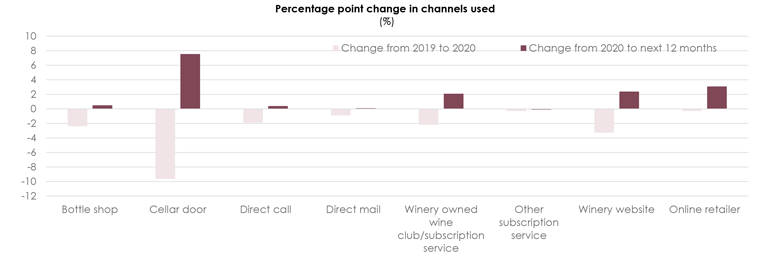A new report, released today, has provided a range of insights into Australia’s domestic market consumer’s behaviour and how these have been impacted by COVID-19, as well as opportunities for wineries to increase sales through winery-owned channels.
The Wine Channel Purchase Behaviour of Australian Wine Consumers Report is the outcome of a research project commissioned by Wine Australia. More than 1,000 Australian domestic consumers were surveyed for the report, which provides insights into how consumers in the domestic market choose between wine-buying channels in 2019 and 2020, what barriers exist for each channel and how consumer choices and behaviour has been influenced by COVID-19 and associated restrictions.
The wine-buying channels analysed include:
- bottle shop
- cellar door
- online retailers
- winery websites
- wine clubs: winery-owned and non-winery owned, and
- mailing list sales.
The report provides key statistics and analysis of:
- frequency and spend characteristics for each channel,
- changes in wine purchasing behaviour between 2019 and 2020,
- future intentions for purchasing by channel,
- deep dives into characteristics of purchasing from the cellar door, wine club and online channels, and
- barriers to buying online.
Key findings
The most commonly used channels to purchase wine in Australia in 2019 was in person at the bottle shop/drive through, followed by in person at the cellar door and thirdly through online retailers. Nearly all channels experienced a decrease in frequency of use in 2020 given the extensive disruption that COVID-19 had on people’s ability to purchase wine (see Figure 1).
Cellar doors as a wine purchasing channel were greatly impacted in 2020 as a result of COVID-19 restrictions with the percentage of those that used the channel much lower than in 2019. But going forward, consumers surveyed were keen to return.
Online sales overtook cellar doors in 2020 as the second most popular channel for purchasing wine (after bottle-shops). While the popularity of the online channel will continue, once travel returns and cellar doors re-open, the report shows there is likely to be an increase in cellar door sales.
Figure 1: Change in purchase behaviour for the channels (Percentage point change in channels used)

Around a half of consumers surveyed did not buy any wine online since 2019. This is despite three quarters being confident in using the internet to make purchases, with the majority buying other items online. While there are many that will not change their minds about using this channel to purchase wine, there are some common issues raised that could be addressed to encourage use of the channel. Some of these include concerns about damages through delivery or not knowing which website to buy from.
Younger consumers were more likely to purchase wine through non-brick and mortar channels compared to the average. Those aged between 25–34 years and 35–44 years had a greater tendency to purchase wine online in 2019. In 2020, a higher proportion of 25–34 years were purchasing wine when wineries called them directly or sent an email.
The research found that there is an opportunity for wineries to increase direct-to-consumer purchases by focusing on exclusivity (see Figure 2). This was evident at the cellar door with a third of consumers believing that it would encourage them to purchase, especially when some are doing price comparisons while there. This was also a point of difference to be explored between winery owned wine clubs compared to other clubs, and winery websites compared to online retailers.
Figure 2: Areas for improvement for cellar doors (percentage of respondents)

Most consumers are happy to pay a tasting fee while at the cellar door, as long as it is considered to offer value for money and they are provided with a positive experience. Of those that are not willing to pay a tasting fee, most are aged 55 and above.
Compared to an online retailer, respondents tended to spend more per bottle through a winery website – thus it is critical to seek ways of driving more consumers to winery websites. When compared to online retailer websites, a higher proportion of consumers indicated that assistance with using the winery website would improve their ability to purchase wine. Where possible, wineries should review their websites to improve the customer journey. This would include from first landing on the site, finding the information they need and the ease in making a purchase. This is especially important, with one-third of respondents giving up if they run into difficulties while buying online.
Click here to view the Wine Channel Purchase Behaviour of Australian Wine Consumers Report.
